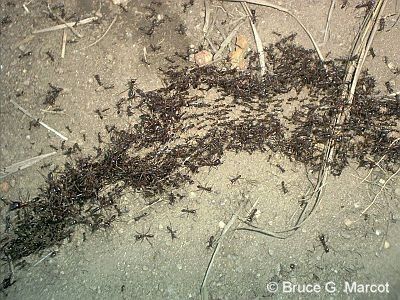Click on the image for a larger version

|
|
Matabele Ant Swarm |
|
|
Click on the image for a larger version

|
|
Matabele Ant Swarm |
|
Matabele Ants (see below for
identification discussion) |
Credit & Copyright: Dr. Bruce G. Marcot
| Explanation:
Do not step here!
This is an advancing column of matabele ants in an open plain of South
Luangwa National Park of eastern Zambia, Africa. Matabele ants form tightly
structured armies and amass by the thousands to raid termitaria (termite nests).
The ants organize their raids by stationing large soldiers with powerful jaws, on the flanks of the column.
The column moves as a unit, all in one direction, out from their mounds, following the ant trail pheromone N,N-dimethyluracil laid by the scout worker ants. Matabele ants sound stridulations as they move (as do some other swarming, predatory ants). Perhaps that was the inspiration for South African master steel-string acoustic guitarist Tony Cox to compose his popular album "Matabele Ants." Matabele ants are named after the Matabele Warriors who advanced through south and central Africa in the 1850s, wiping out villages as they went. Matabele ants are likewise most dangerous; 10 bites can paralyze your arm. Taxa such as Megaponera foetens have a kind of swarming "army ant behavior" or "Matabele ant behavior" (which means behavior of warriors). Information: |
| Updates on Species Identification |
| EPOW reader Marcus Stüben,
Ph.D. biology student at Theodor-Boveri-Institut für Biowissenschaften der Universität Würzburg
(Biozentrum) in Würzburg, Germany, suggests that the species shown on
this page might not be "Megaponera foetens" (which is a
synonym of the valid name Pachycondyla analis, Ponerinae, Ponerini), but rather
army ants, Dorylus
species (Dorylinae), on a swarm raid. Stüben wrote that Pachycondyla analis is a blackish species and has normally less numerous raiding parties.
* * * * However, another EPOW reader, Simon Williams of the BBC Natural History Unit in Bristol U.K., has written that the species shown likely is Megaponera foetens. * * * * Further, Dr. James C. Trager, Restoration
Biologist and Ant Taxonomist with Shaw Nature Reserve, Gray Summit, MO,
wrote that the species shown is "one of the African driver ants,
probably Dorylus
wilverthi. He wrote, "Note the polymorphic workers, with large-headed majors guarding the flanks of the column"
and that "Pachycondyla spp. by contrast have monomorphic workers,
for example, this South American termite raiding species.
Apparently, the name "Matabele ant" is used by some authors for both Dorylus and Megaponera species, although Dorylus is actually a real army ant. * * * * Some time later, EPOW reader Doug Grewar (resident of Zululand, South Africa, and who grew up in Zambia), conveyed that he too is trying to sort out the confusing names of Red or Driver or Siafu ants and to determine their correct Latin names. He suggests that the EPOW photos on this page are Siafu ants, and provided some of his own photos and stories of such. He also suggests that both red Siafu and black Matabele ants seem to be referred to as "Safari ants," and "I have now found the chiBemba names for red driver ants is impashi and the larger black Matabele ants is iminangu. Bemba is the major language in Zambia although in the Luangwa valley area, where you visited, chiNyanja would be common." My thanks to Doug for also sending extensive stories, photos, links, and descriptions of various of these ant types. * * * *
|
Next week's picture: Vaux's Swifts
Member Theme of Taos-Telecommunity